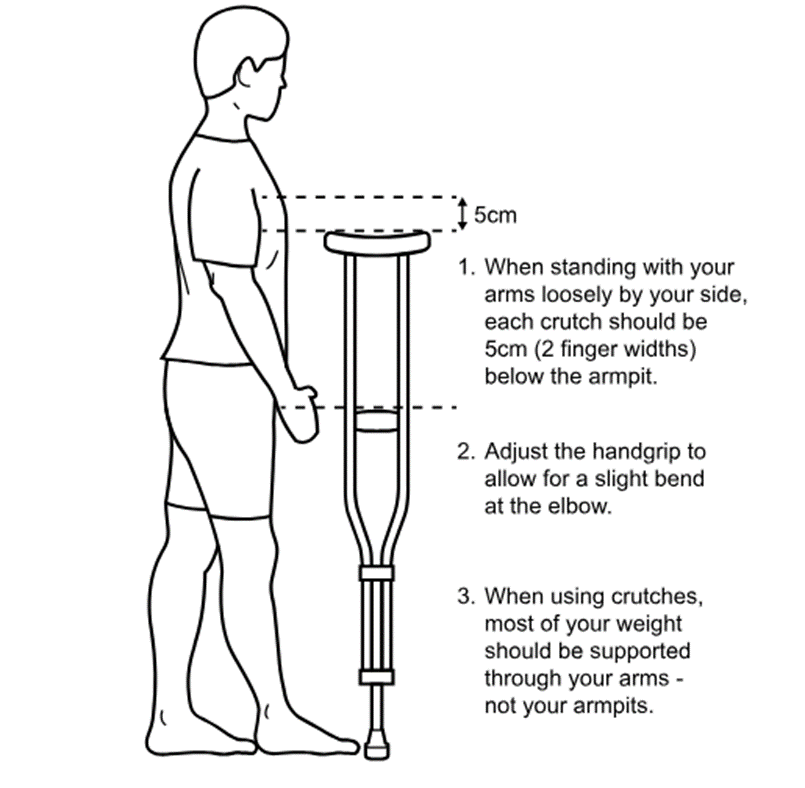The nurse is teaching a client about how to use crutches. Which action performed by the client demonstrates to the nurse a correct understanding of how to use the crutches?
Walks with the arms fully extended.
Fits the crutch 2 finger widths from axilla.
Avoids adjusting the height of the hand grips.
Holds the crutch 6 inches (15 cm) to the side.
The Correct Answer is B
Choice A reason: This is an incorrect action as it indicates poor posture and balance. The client should walk with the elbows slightly flexed and the shoulders relaxed.
Choice B reason: This is the correct action as it ensures proper fit and comfort of the crutch. The client should fit the crutch 2 finger widths from the axilla to prevent nerve damage and pressure ulcers.

Choice C reason: This is an incorrect action as it may cause pain and injury to the wrists and hands. The client should adjust the height of the hand grips to allow a 30-degree bend at the elbow.
Choice D reason: This is an incorrect action as it may cause instability and falls. The client should hold the crutch 4 to 6 inches (10 to 15 cm) in front and to the side of the foot.
Nursing Test Bank
Naxlex Comprehensive Predictor Exams
Related Questions
Correct Answer is B
Explanation
Choice A reason: Requesting a family member to remain with the client is not the best intervention to implement first. It may provide some emotional support, but it does not address the communication barrier. The family member may not be able to translate accurately or objectively, and may have their own biases or emotions.
Choice B reason: Obtaining a staff member who is a bilingual interpreter is the best intervention to implement first. It ensures effective communication and understanding between the nurse and the client. It also respects the client's cultural and linguistic preferences and needs.
Choice C reason: Using drawings that are universal for all cultures is not the most effective intervention to implement first. It may be helpful for some simple concepts, but it may not convey the full meaning or context of the assessment. It may also be misinterpreted or misunderstood by the client.
Choice D reason: Asking for the support of one of the client's friends is not the most appropriate intervention to implement first. It may violate the client's privacy and confidentiality, and may not ensure accurate or unbiased translation. The friend may not be familiar with the medical terminology or the client's condition.
Correct Answer is D
Explanation
Choice A reason: Muscle strength and tone is not the most important assessment for the nurse to perform prior to the application of a heating pad. It may be relevant for some clients who have musculoskeletal problems, but it does not indicate the risk of thermal injury.
Choice B reason: Limitations to range of motion is not the most important assessment for the nurse to perform prior to the application of a heating pad. It may be relevant for some clients who have joint stiffness or pain, but it does not indicate the risk of thermal injury.
Choice C reason: Presence of rebound phenomenon is not the most important assessment for the nurse to perform prior to the application of a heating pad. It is a sign of peritoneal inflammation that occurs when pressure is released from the abdomen. It has nothing to do with the application of a heating pad.
Choice D reason: Degree of neurosensory impairment is the most important assessment for the nurse to perform prior to the application of a heating pad. It indicates the client's ability to perceive heat and pain sensations. If the client has impaired neurosensory function, the nurse should avoid using a heating pad or use it with caution and frequent monitoring.
Whether you are a student looking to ace your exams or a practicing nurse seeking to enhance your expertise , our nursing education contents will empower you with the confidence and competence to make a difference in the lives of patients and become a respected leader in the healthcare field.
Visit Naxlex, invest in your future and unlock endless possibilities with our unparalleled nursing education contents today
Report Wrong Answer on the Current Question
Do you disagree with the answer? If yes, what is your expected answer? Explain.
Kindly be descriptive with the issue you are facing.
